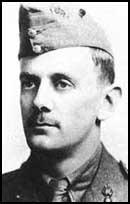Lanoe George Hawker

Lanoe George Hawker was born in Longparish, Hampshire in 1890. He joined the Royal Flying Corps and soon developed a reputation as an aggressive pilot. Flying a BE-2 he successfully attacked the Zeppelin plant at Gontrobe in April 1915 and was afterwards awarded the Distinguished Service Order.
On 25th July 1915 Hawker became the first fighter pilot to win the Victoria Cross for air combat. Flying a single-seater Bristol Scout and armed with a single-shot cavalry carbine mounted on the starboard side of the fuselage, Hawker attacked an enemy two-seater over Ypres. After forcing it to land he brought down two more enemy planes. What made the achievement so remarkable was that all three German aircraft were armed with machine-guns.
Promoted to the rank of major, Hawker died after taking part in one of the longest dogfights of the war. Flying an Airco DH-2 over Bapaume on 23rd November, 1916, Hawker was eventually shot down and killed by Manfred von Richthofen.
Primary Sources
(1) London Gazette (8th May, 1915)
For conspicuous gallantry on 19 April 1915, when he (Hawker) succeeded in dropping bombs on the German airship shed at Gontrode from a height of only 200 feet under circumstances of the greatest risk. Lieutenant Hawker displayed remarkable ingenuity in utilizing an unoccupied German captive balloon to shield him from fire while maneuvering to drop the bombs.
(2) London Gazette (24th August, 1915)
For most conspicuous bravery and very great ability on 25 July 1915. When flying alone he attacked three enemy aeroplanes in succession. The first managed eventually to escape, the second was driven to the ground damaged, and the third, which he attacked at the height of about 10,000 feet, was driven to earth in our lines, the pilot and observer being killed. The personal bravery shown by this officer was of the very highest order, as the enemy's aircraft were armed with machine guns, and all carried a passenger as well as a pilot.
(3) In his book, Red Air Fighter, Manfred von Richthofen, described killing Lanoe George Hawker.
In view of the character of our fight it was clear to me that I had been tackling a flying champion. One day I was blithely flying to give chase when I noticed three Englishmen who also had apparently gone a-hunting. I noticed that they were watching me and as I felt much inclination to have a fight I did not want to disappoint them.
I was flying at a lower altitude. Consequently I had to wait until one of my English friends tried to drop on me. After a short while one of the three came sailing along and attempted to tackle me in the rear. After firing five shots he had to stop for I had swerved in a sharp curve.
The Englishman tried to catch me up in the rear while I tried to get behind him. So we circled round and round like madmen after one another at an altitude of about 10,000 feet.
First we circled twenty times to the left, and then thirty times to the right. Each tried to get behind and above the other. Soon I discovered that I was not meeting a beginner. He had not the slightest intention of breaking off the fight. He was traveling in a machine which turned beautifully. However, my own was better at rising than his, and I succeeded at last in getting above and beyond my English waltzing partner.
When we had got down to about 6,000 feet without having achieved anything in particular, my opponent ought to have discovered that it was time for him to take his leave. The wind was favorable to me for it drove us more and more towards the German position. At last we were above Bapaume, about half a mile behind the German front. The impertinent fellow was full of cheek and when we had got down to about 3,000 feet he merrily waved to me as if he would say, "Well, how do you do?"
The circles which we made around one another were so narrow that their diameter was probably no more than 250 or 300 feet. I had time to take a good look at my opponent. I looked down into his carriage and could see every movement of his head. If he had not had his cap on I would have noticed what kind of a face he was making.
My Englishmen was a good sportsman, but by and by the thing became a little too hot for him. He had to decide whether he would land on German ground or whether he would fly back to the English lines. Of course he tried the latter, after having endeavored in vain to escape me by loopings and such like tricks. At that time his first bullets were flying around me, for hitherto neither of us had been able to do any shooting.
When he had come down to about three hundred feet he tried to escape by flying in a zig-zag course during which, as is well known, it is difficult for an observer to shoot. That was my most favorable moment. I followed him at an altitude of from two hundred and fifty feet to one hundred and fifty feet, firing all the time. The Englishman could not help falling. But the jamming of my gun nearly robbed me of my success.
My opponent fell, shot through the head, one hundred and fifty feet behind our line
